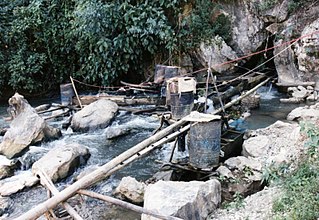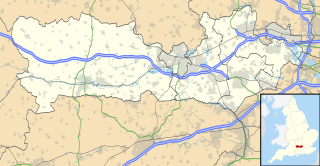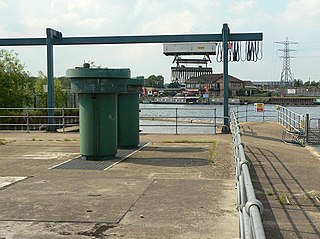
The Shannon hydroelectric Scheme was a major development by the Irish Free State in the 1920s to harness the power of the River Shannon. Its product, the Ardnacrusha power plant, is a hydroelectric power station which is still producing power today and is located near Ardnacrusha within County Clare approximately 2.4 kilometres (1.5 mi) from the Limerick border. It is Ireland's largest river hydroelectric scheme and is operated on a purpose built headrace connected to the River Shannon. The plant includes fish ladders so that returning fish, such as salmon, can climb the river safely past the power station.

Micro hydro is a type of hydroelectric power that typically produces from 5 kW to 100 kW of electricity using the natural flow of water. Installations below 5 kW are called pico hydro. These installations can provide power to an isolated home or small community, or are sometimes connected to electric power networks, particularly where net metering is offered. There are many of these installations around the world, particularly in developing nations as they can provide an economical source of energy without the purchase of fuel. Micro hydro systems complement solar PV power systems because in many areas, water flow, and thus available hydro power, is highest in the winter when solar energy is at a minimum. Micro hydro is frequently accomplished with a pelton wheel for high head, low flow water supply. The installation is often just a small dammed pool, at the top of a waterfall, with several hundred feet of pipe leading to a small generator housing. In low head sites, generally water wheels and Archimedes screws are used.

Guthega Power Station is located in the Snowy Mountains region of New South Wales, Australia. The power station's purpose is for the generation of electricity. It is the first to be completed and smallest of the initial seven hydroelectric power stations that comprise the Snowy Mountains Scheme, a vast hydroelectricity and irrigation complex constructed in south-east Australia between 1949 and 1974 and now run by Snowy Hydro.

The Tuloma River is a river in Murmansk Oblast in Russia. With a drainage basin of 21,500 square kilometres (8,300 sq mi) and an average discharge at 255 m³/s, the Tuloma is one of the biggest rivers in northern Fennoscandia.

Sandford Lock is a lock on the River Thames in England, situated at Sandford-on-Thames which is just South of Oxford. The first pound lock was built in 1631 by the Oxford-Burcot Commission although this has since been rebuilt. The lock has the deepest fall of all locks on the Thames at 8ft 9in (2.69m) and is connected to a large island which is one of three at this point. The lock lies at the end of Church Lane in Sandford on Thames.

Romney Island is an island in the River Thames in England connected to Romney Lock, at Windsor, Berkshire. It is a long thin island with trees and scrub, with the upstream end in Windsor and the downstream end almost at Black Potts.

Torrs Hydro is a micro hydroelectric scheme, owned by the community, in New Mills, Derbyshire. It is located on the River Goyt, immediately after its confluence with the River Sett at the Torr weir. A 2.4-metre diameter steel trough screw turbine generates up to 63 kW of electricity.

Settle Hydro is a micro hydroelectric scheme, owned by the community, in Settle, North Yorkshire, England. It is located on the River Ribble, at Settle Weir near Bridge End Mill. It uses part of the former mill race. A reverse Archimedean screw generates 50 kW of electricity.

Beeston Hydro is a micro hydroelectric scheme, in Beeston, Nottinghamshire. It is located on the River Trent, and generates up to 1.66 MW of electricity.

Carrigadrohid hydroelectric power station is a hydroelectric plant located on the River Lee in County Cork, Ireland. It is owned and operated by the ESB Group.

Cathaleen's Fall hydroelectric power station is a hydroelectric plant located on the River Erne at Ballyshannon in County Donegal, Ireland. It is owned and operated by the ESB Group. The plant is also known as Ballyshannon.

The River Bain Hydro is a hydroelectric generator based on the River Bain in the village of Bainbridge, North Yorkshire, England. It powers most of the properties in the village, with excess electricity being sold off to the national grid. It was opened in 2011 with an installed capacity of 45kW, and is expected to last 40 years. It is a low demand ecofriendly scheme, and more hydro electric power generators are being manufactured to provide green energy at a low cost.

Ruswarp Hydro or Whitby Esk Energy, is a Hydroelectric generation scheme that operates on the River Esk at Ruswarp, North Yorkshire, England. The project uses an Archimedes Screw in a reverse direction to generate electricity and was funded by people in the community. Around 4 tonnes of water pass along the screw per second, which generates enough electricity to power 45–48 homes.

Burley Hydro Scheme also known as Greenholme Mill Hydro is a micro hydroelectric scheme installed on the River Wharfe at Burley-in-Wharfedale, West Yorkshire, England. The power output of the hydro scheme is 330 kWh with an annual output of 1,400 MWh and is the fourth hydro scheme on the river after the opening of similar power plants at Linton near Grassington, and two further downstream from Burley at Pool-in-Wharfedale and Garnett Wharfe at Otley. All of these schemes have been located on sites previously used to generate power from the water flow.

Linton Lock Hydro is a hydroelectric plant on the River Ouse in North Yorkshire, England, between the villages of Linton-on-Ouse and Nun Monkton. The first hydroelectric scheme was built here in 1923, but that was abandoned in the early 1960s. The second scheme to be sited at Linton Lock was installed in 2011 and a new generating unit came on stream in 2017. The combined output from the second and third generation plants is 380 kWh, which is enough to power 450 homes.

Linton Falls Hydro is a hydroelectric generating power station located on the Linton Falls Weir of the River Wharfe, near Grassington, North Yorkshire, England. The power station is located on the same site as a hydroelectric scheme that was first opened in 1909, but had closed by 1948. The new scheme, which opened in March 2012, uses the original building which is now a scheduled monument.

Kirkthorpe hydro is a hydroelectric generating plant located on the River Calder at Kirkthorpe Weir, 4 miles (6.4 km) east of the City of Wakefield in West Yorkshire, England. The pant was opened in 2017 and expects to be generating electricity for 100 years. Kirkthorpe Weir is the highest industrial weir in Yorkshire and has prevented fish passing upstream to spawn; the new hydro project has a fish pass built into it.



























